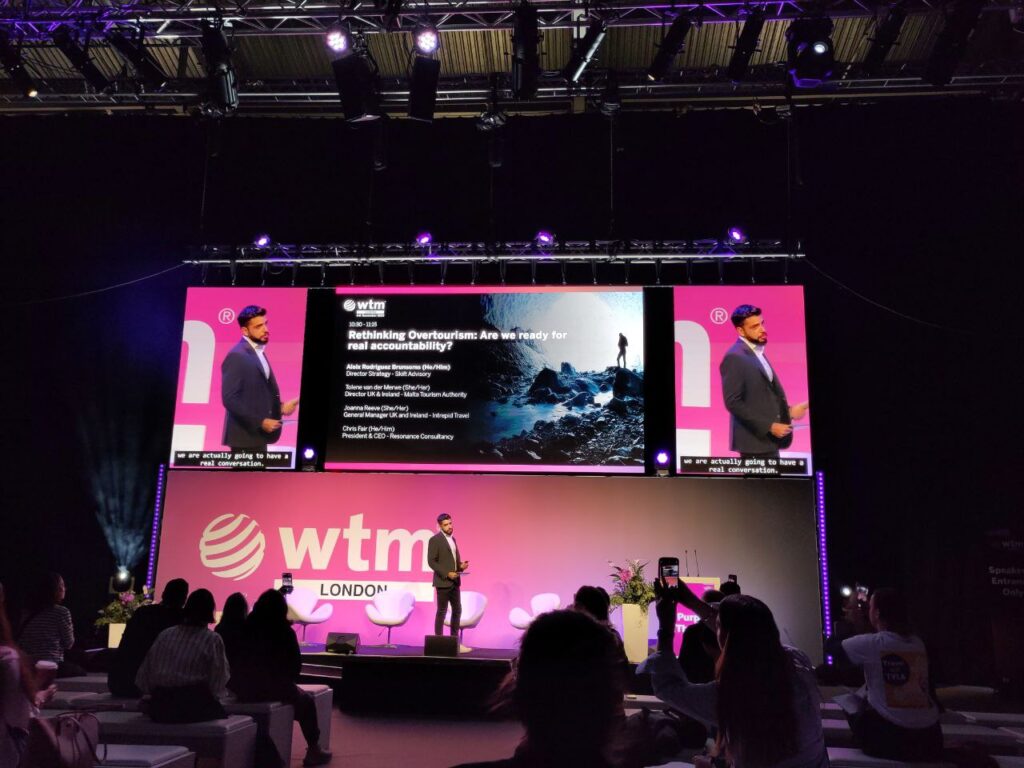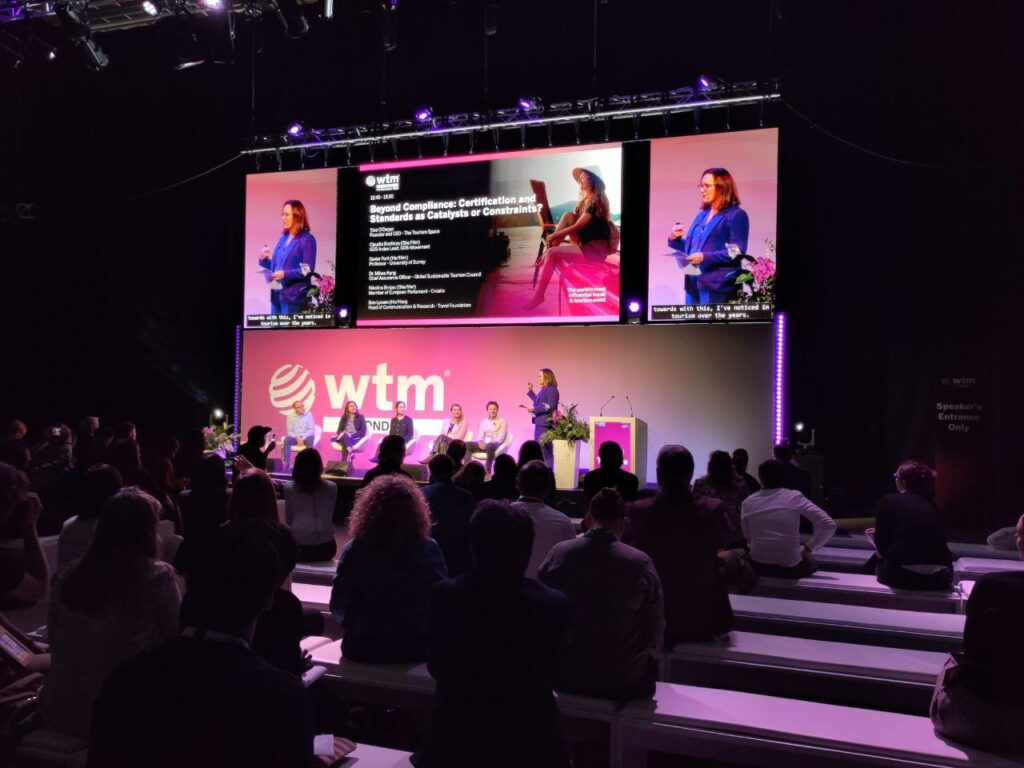WTM London 2025 confirmed itself as one of the most significant trade events of the year for the global tourism industry. With notable growth, a rich programme of content and the participation of over 180 countries, the event showcased — at least on paper — strong momentum.
However, my personal and professional experience, together with the daily insights I shared on LinkedIn during the three days of the fair, reveals a more nuanced picture: a combination of highly positive elements and critical aspects that deserve attention.

Overview of the Event
Key Figures
- 46,500 attendees, the highest number recorded
- 5,500 qualified buyers (+8% compared to 2024)
- 182 countries represented
- +25% exhibition space
- Over 40,000 pre-scheduled meetings
- Estimated business generated: over £2.2 billion
The event took place at ExCeL London from 4–6 November 2025, in a lively, business-oriented atmosphere.

Key Trends Emerging in 2025
The TrendFest
One of the most highlighted innovations was the TrendFest, an experiential area featuring shows, performances and innovative exhibitors.
The format worked well, generating a constant and dynamic flow of visitors and emerging as one of the event’s main attractions.
Technology & Travel Tech
The growth of the tech sector was evident: digital solutions, AI platforms, integrated systems and new tools designed to improve both the traveller experience and industry operations were among the major highlights of 2025.
Experiential Tourism
Many exhibitors focused on immersive narratives, storytelling and sensory content — a now well-established trend within the sector.
My Personal Experience
For me, WTM 2025 felt like a return — stepping back into a professional space I know well and with which I have a long-standing connection.
What Worked Well
- I organised productive meetings with long-standing contacts, making my participation truly worthwhile.
- I reconnected with colleagues, partners and stakeholders involved in sustainability, responsibility, culture and local development.
- From a personal point of view, the experience was inspiring: the three days were intense and stimulating, as I shared in my daily LinkedIn updates (Day 1, Day 2 and Day 3).
The Topics I Contributed to at WTM
Throughout the event, I contributed to the broader discussion on:
- Digital pollution (Day 2)
- Overtourism and responsible management (Day 3)
- Tourism perception, local development, and responsibility in the sector.
I found excellent discussions in the panels and workshops, often rich in practical insights.

Critical Issues Identified (and Why They Matter)
Limited Access to the Participant List
One major issue is the inability for Visitor/Trade pass holders to access the full list of participants, buyers and exhibitors, unless they purchase an upgrade costing around £500.
This:
- significantly limits networking opportunities,
- makes meeting preparation more difficult,
- penalises independent professionals and projects with limited budgets.
For me, this is a key factor that reduces the value of attending WTM as a visitor.
Questionable Positioning of Certain Areas
While the TrendFest area was well designed, I found the decision to place the Africa section in a peripheral and less visible location quite unfair.
My position is clear:
The most attractive area should host those who generate value, not simply those with larger budgets.
Placing Africa far from the centre of the fair risks making a vibrant continent — rich in culture, innovation and responsible tourism proposals — less visible.
Absence of Awards, Such as the Responsible Tourism Awards
Unlike past editions, the absence of awards ceremonies dedicated to responsible tourism — such as the Responsible Tourism Awards — had a visible impact:
- fewer opportunities for spontaneous interaction among sector professionals,
- fewer moments for targeted networking,
- Reduced visibility for operators who are often small, innovative and working with limited budgets.
These awards were not only a way to celebrate excellence but also a powerful tool for building community.
No Dedicated Space for Responsible Tourism
Although WTM offered excellent panels and high-quality workshops, the 2025 edition lacked a dedicated physical space for responsible tourism operators.
Not in the TrendFest, nor anywhere else.
For those — like me — who work in sustainability, responsibility, inclusivity and accessibility, this is a clear signal:
Interest in responsible tourism is expressed more in words than in concrete action.

The Comparison with ITB Berlin
While WTM 2025 did offer more break areas than in 2019 — a positive aspect facilitating quick conversations and impromptu meetings — the event still displays a more fragmented approach to space organisation.
At ITB Berlin, free spaces are fewer, but the fair compensates through strongly characterised thematic sectors, such as those dedicated to responsible tourism and the LGBTQ+ travel segment.
These curated and visible areas make a significant difference: even if certain organisations are not listed in the agenda or directory, visiting that sector is enough to meet operators, experts and key stakeholders.
Having a recognisable physical hub makes networking more natural and efficient, reducing the dispersion typically experienced at WTM.
Another difference lies in the management of presentations.
At WTM, many sessions take place in closed, dimly lit rooms — effective for concentration, but isolating the talks from the broader experience of the fair.
At ITB, stages are more open, brighter and fully integrated into the exhibition flow.
This turns presentations into real gathering points — places to meet colleagues, start conversations and arrange informal meetings — making sessions a collective experience rather than a separate activity.
Conclusion
WTM London 2025 was an important, engaging event filled with opportunities.
It remains an extraordinary place to meet professionals from around the world and to understand where the global tourism industry is heading.
However, it is an event that can — and should — improve, especially concerning:
- fairness in exhibitor visibility,
- access to information,
- dedicated spaces for responsible innovation,
- tangible inclusion of the sustainable tourism sector.
Personally, I take home:
- many stimulating conversations,
- the joy of returning to WTM,
- new projects to develop,
- and the awareness that the industry still has a long way to go to transform panel-level intentions into concrete actions.
Responsible tourism is not a trend — it is a pillar.
And it deserves space, recognition and concrete investment — especially at global events like WTM.
Sara
Would you like to subscribe to my newsletter? In English, I am using the LinkedIn newsletter. I want to use it because I can learn more about who has subscribed from the LinkedIn profile. Here is the link: https://www.linkedin.com/newsletters/7107445901593313280/